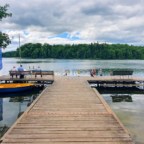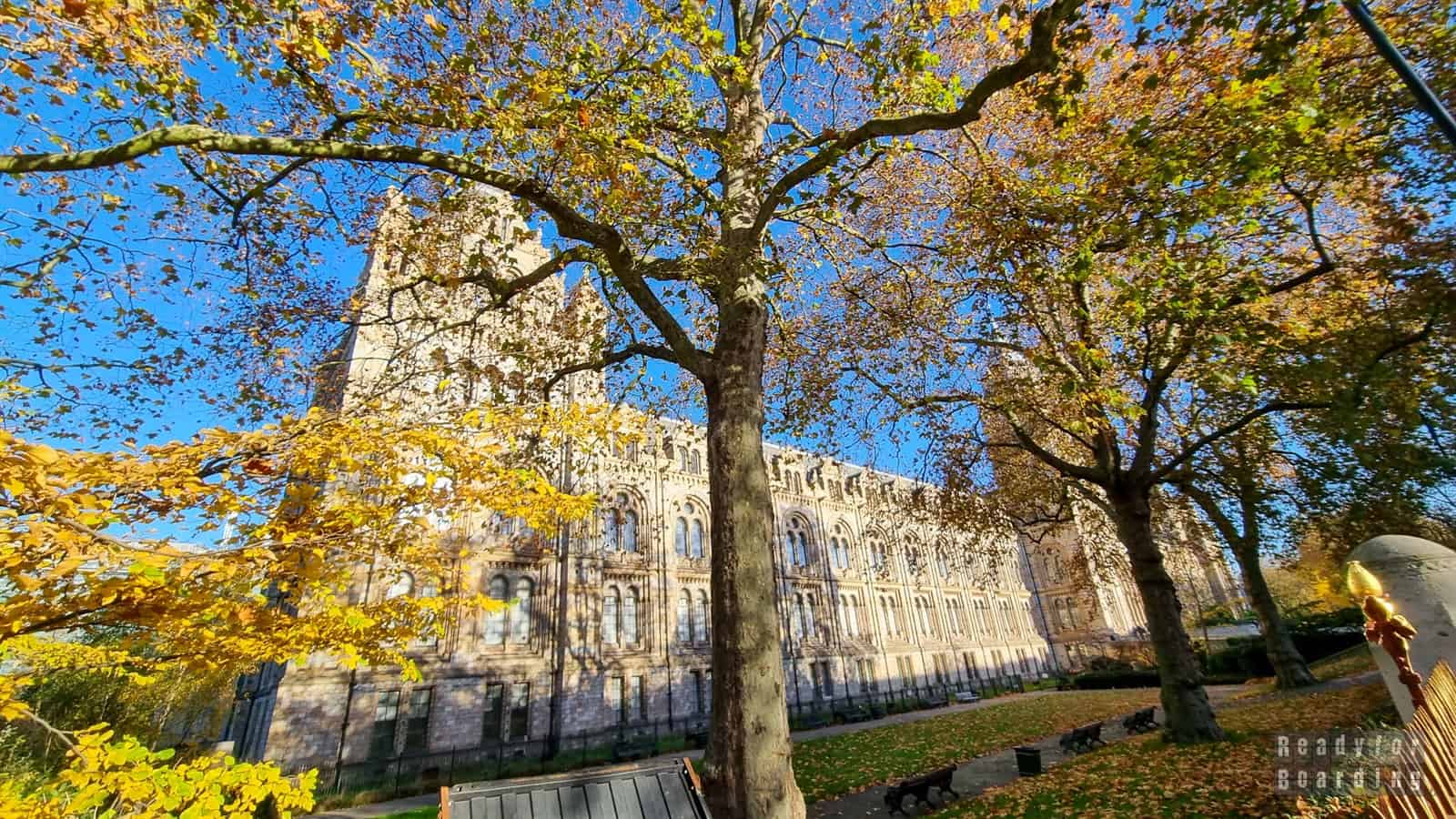There are cities where you visit often, but only in passing, and it turns out that you never had the opportunity to learn about its history, culture or at least its monuments. Piotrków Trybunalski was such a city for us. It was, because we managed to rediscover it over the May weekend.
In Piotrków Trybunalski we used to visit often. Or put another way, we often passed through Piotrków on our way to southern Poland or even to Sulejów or the Belchatow area. We were at some events, visiting friends, or just stopping for some food en route. We occasionally walked to the old town, but never spent a whole day deliberately exploring the city with a map or guidebook and looking for sights. We finally decided to change that and dedicated one day in May to discovering the city, which received city rights much earlier than our dear Lodz!
Let’s start with the fact that in Piotrkow Trybunalski several trails have been prepared for you to follow, and among them you will find: a trail of historical monuments, a film trail, a trail of many cultures, a Jewish trail, etc. There is something for everyone, and it’s best to look at the sites from all the trails, choose the ones that interest you and work out the route yourself.
Below you can see the places we have targeted and seen.
Table of contents
Railway Station
We started our tour of Piotrkow Trybunalski from the train station. Even if you come to the city by car, there is a parking lot right next to the station building where you can leave your car and start exploring from there.
Immediately you can see that the station is renovated, well-maintained and quite sizable. Its origins date back to the mid-19th century when it was built as part of the Warsaw-Vienna Railway (also known as the Warsaw-Vienna Iron Road).
Vienna). The main station building has since retained its shape and function, and the entire facility underwent a major renovation in 2010-2012.
[source]
.
Next door is a smaller brick building housing stores and bars, and another building in the same style as the main building. There is some greenery in the station area, with pink-blooming chestnut trees adding extra charm. We were surprised by the small playground for children! :) Until now, we have not seen such facilities at any railroad station in Poland, and in our opinion it is a hit! :)
There are quite a few food stalls both in the station area and across the street, where kebabs rule. Nevertheless, you will also find tasty ice cream shops, cafes and restaurants in the area.
Water tower
The building that immediately catches your eye upon leaving the station is the water tower across the street – perhaps the most distinctive point on the city map. This neoclassical tower was built by American investors (Ulen & Company) between 1925 and 1926, and its form is reminiscent of the Renaissance. The city’s coat of arms was placed on its upper part.
But wait a minute… wondering where the American capital in Piotrkow Trybunalski comes from! Well, the aforementioned Ulen & Company of New York offered Polish cities a $10 million loan for the creation of water supply and sewage systems in major cities, to which Piotrków Trybunalski volunteered (other cities included Częstochowa, Lublin, Radom and others). You can see historic photos of the tower’s construction here.
A 1928 pump that could pump water to a height of 32 meters is erected at the entrance, with a capacity of 220 cubic meters per hour.
Slowackiego Street
One walks along Slowackiego Street towards the Tribal Market. However, before this street turns into a street. Sieradzka Street, which leads straight to the main square, it is worth noting some interesting buildings along the street.
The first is the Orthodox Orthodox Church of the Holy Cross. All Saints. Its construction was completed in 1848, and it underwent an expansion that was completed in 1970. On the other side of Slowackiego Street, you can relax in a square with benches and a fountain.
On the same side of the street as the church, a piece farther toward the market, is a white courthouse designed by Felix Nowicki and built in 1909. From 1975 to 1979, the Provincial Office was headquartered here.
Moving on, on the other side we pass the Sanctuary of Our Lady of Piotrkowska. There is the church of St. Peter’s. Our Lady of the Angels and the monastery of the Fr. Bernardine Church, built in 1643. You can also see from here, located on the opposite side of the intersection, a fragment of the city walls from the 14th and 15th centuries, as well as the complex of the former convent of the nuns. Dominican Sisters (there is a church dedicated to Our Lady of the Snows and a convent). It is worth mentioning that the Center for Ideas “Towards Democracy” is located here, where many interesting artistic events are held.
Old town in Piotrkow Trybunalski
Where the street ends. Slowackiego and begins with ul. Sieradzka we entered a territory of the old town, where car traffic is limited. We passed renovated tenements, as well as those that are still waiting for better times, and for the time being more layers of plaster are falling off them.
Before heading to the market itself, however, we walked in a northerly direction along Rwanska Street to the Baroque Evangelical Augsburg Church located here, built in 1718. The front of the church stands out significantly from the other buildings on the street, and by no means only in its architecture and size. It immediately catches the eye, by the way, see for yourself:
Initially, there was a church of the Fr. The Piarists, however, was abandoned after a fire. In 1793 it was purchased by the Prussian authorities and assigned to a Protestant parish. The church was closed, but we could see the modest interiors through the glass windows.
Next to the church is the former prison, which served its function until 2003 (before that there was a college of the Piarist Fathers here). Although there are now stores and restaurants here, there are still remnants of the prison such as the guard tower – this is what made us pay more attention to this building. Anyway, you can see that the place is just meant to attract in this way, as the Old Jail shopping mall has been established here, and the names refer to the former function of the building.
We walked in this direction to see the Church of the Holy Cross on the other side of Wojska Polskiego Street. St. The company’s products include St. Jack’s and St. The building was erected in the first half of the 15th century. It is said to have been founded by Casimir the Great. Since it was a Sunday in May, we just happened to hit communion, but after a brief stopover we managed to look inside for a while.
From there, we returned to the Tribune Market via pl. Czarnieckiego, at which there is a bourgeois house from the 18th century, owned by the Grabowski family, which is now the headquarters of PTTK. In Czarniecki Square there is a small information point related to the film trail through Piotrkow, through which we learned what films were filmed here.
The Tribal Market is a square with townhouses all around, in which, on the first floors, there are numerous restaurants (some of them, unfortunately, were closed due to special events – we forgot that communions were starting and our dinner plans for the day were thwarted). The townhouses are mostly renovated and refurbished. All in all, we did not expect to find such a beautiful and restored old town in Piotrkow Trybunalski. You can see by the many plaques on the buildings that this is largely due to European Funds, including the Regional Operational Program of the Łódź Province.
From each corner of the market, there are two streets where craftsmen were located – on ul. A commemorative plaque with the coats of arms of the Piotrków crafts guilds was even erected at Farna Street to emphasize the participation and role of craftsmen in the creation of the city.
On the corner of Szewska and Łazienna Mokra Streets is the Museum of Brewing, along with a store that abounds not only in liquor but also beer-based cosmetics. Unfortunately, the museum was reserved for another group and, not knowing why, we were not allowed to visit it at that time (even though you visit on your own), but we could at least learn some interesting facts about Piotrków breweries and stock up on beers that are hard to find in Lodz.
Then, we took our steps to the shrine of Our Lady of the Tribunal, with the Church of St. Mary of the Tribunal. St. The location of which immediately brought to mind St. Francis Xavier Parish in Poznan. The more modest, more subdued facade adds a certain austerity to the church. Inside, on the other hand, it is decidedly more opulent and stately.
Here we can find polychromes from the first half of the 18th century, but for the past few years it has been another object that has caught the eye. We are talking about the image of the Virgin Mary with Child, the so-called “Mother of God”.
Our Lady of Tribune, which was crowned by Pope Benedict XVI in 2006.
Just “over the wall” is the former Jesuit and Piarist Collegium Novum (now a high school).
Above the city reigns the massive brick bell tower, which is located across Farna Street – it is part of the Gothic Farny Church of the Holy Cross. St. James. Its origins date back to the 14th century, and the bell tower was built in the 15th century.
Royal Castle
Piotrkow Trybunalski is home to the brick, 4-story high Royal Castle, although it did not have a military function as such. It was commissioned by King Sigismund I the Old in 1520 and was the residence of the last Jagiellons (although the first initiator was Casimir the Great, but it turned out that the castle built was too small).
It now houses a three-level museum, and inside we can see both temporary exhibitions and permanent displays showing the history and monuments of Piotrkow Trybunalski. Akurat during our visit the entrance was free, although we didn’t find anywhere information about the price of tickets, so maybe it’s free every day :)
The building’s exterior is fully renovated, which definitely invites you to take a look inside. Although we have to admit that we were most interested in the model of old Piotrkow Trybunalski and the view from the windows of the Old Town.
Opposite the entrance to the castle grounds there is a square, Castle Square, with benches and a playground – this is also the result of European Fund support from the Regional Operational Program of the Lodz Voivodeship. As, by the way, many tenements are or will be renovated in the Piotrkowskie Podzamcze area.
On the other side of the street. Jerusalem Street is home to the Great Synagogue and a Jewish school (both from the 18th century) – now there is a library for children and adults, and the building itself, even from the outside, deserves a few minutes of extra walking :)
Summary
It was a very nice Sunday. We saw a city we’ve been to many times, and never spent a whole day exploring.
We learned about the history, managed to exchange a few words with the locals, discovered new places, and above all saw how Piotrkow Trybunalski is changing.
Wandering through the streets of Piotrkow, we could see how step by step a revolution is taking place in the city – as we have already mentioned, here we passed both beautifully restored tenements, those covered with construction sheets and those still in line for restoration. Buildings are changing, streets are changing – new sidewalks, planted trees, squares and resting places make even those streets where tenements still need major renovations more friendly and clean – these places have been renovated with the support of European Funds.
PS. With this post, we begin our new series of travel posts on the Lodz Voivodeship as part of our #changinglodz campaign. As freshly minted Ambassadors of the Lodz Voivodeship :-) we will show you interesting places and events not only for weekend trips, including those that have changed just thanks to the European Union.
We also invite you to visit the photo gallery of our entire trip:
Zobacz galerię wszystkich zdjęć z Piotrkowa Trybunalskiego >>>
The project “The Route of Many Cultures – Development of the city’s tourism potential through the revitalization of historic areas of Piotrków Trybunalski” is co-financed by the European Union from the European Regional Development Fund and the state budget under the Regional Operational Program of the Łódzkie Voivodeship for the years 2007-2013 (contract numbers: UDA-RPLD.06.01.00-00-005/09-01 and UDA-RPLD-06.01.00-00-001/13-00).
The project “Spatial development of the conservation area – Dworcowy Trakt, stage I – square in front of the railway station” is co-financed by the European Union from the European Regional Development Fund and the state budget as part of the Regional Operational Program of the Lodz Voivodeship for 2007-2013 (contract number: UDA-RPLD.06.01.00-00-008/11-00).
The project “Łask – Łódź – Piotrków Trybunalski – towards democracy, humanism, multiculturalism – the creation of three centers of ideas” is co-financed by the European Union from the European Regional Development Fund and the state budget under the Regional Operational Program of the Łódzkie Voivodeship for the years 2007-2013 (contract number: UDA-RPLD.05.04.00-00-004/09-03).
–
Are you looking for other travel inspiration for the Lodz region? We also recommend our other entries:
- Ideas for day trips in central Poland – Lodz area,
- and
attractions for children in lodz voivodship
,
Lodz Zoo and Orientarium
– the best is yet to come- Uniejów Thermal Baths and other attractions in the area
Clement’s Orchards
– Rest and fun in apple orchards- Attractions for children in Lodz
- Nieborów – palace and park complex
Old Village
– The place on earth where you turn on airplane mode
Dinopark Kolacinek
– What did the dinosaurs chew on? :)- EC1 Łódź – New Center of Lodz
Collegiate Church in Tuma
and the legend associated with the devil Boruta- Idea for the weekend: macro insects in Microcosmos
- Lodz – our TOP 10 attractions in Lodz













































